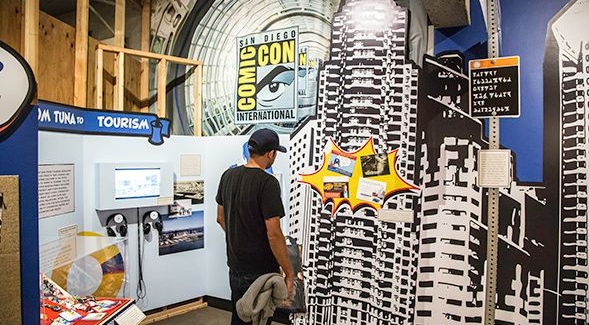SDSUxCOMIC-CON: Just How Much Money Does Comic-Con Make For San Diego?
The city's annual comic convention pumps millions of dollars into San Diego's economy each year, but it could all vanish in 2025.

As it enters its 53rd year in San Diego, Comic-Con International has evolved from a small gathering of comic book and science fiction enthusiasts gathered in the basement of the U.S. Grant Hotel in 1970 to a mega-event that has outgrown the 2.6 million-square-foot San Diego Convention Center.
As the city’s largest annual convention, the event brings tens of thousands of people to downtown San Diego while they eat, sleep, attend events and move throughout the metropolitan area.
Miro Copic, marketing lecturer and branding expert at the Fowler College of Business at San Diego State University discussed how attendees will spend their money and what it means to the city.
Can you talk a little about the economic impact Comic-Con International has on the San Diego area?
Comic-Con is the premier event in San Diego’s year. This is one event that puts San Diego on the global map. Before the pandemic, Comic-Con attracted over 135,000 registered fans from all over the world, along with over 2,500 members of the media from more than 30 countries. The impact to the local San Diego economy is over $165 million in overall spending with over $90 million in direct attendee spending. This means that the average attendee spends nearly $700 when they are here. The City of San Diego will collect over $3.2 million in hotel and sales tax revenue, so this is a big boon to the city given that Comic-Con is bigger than the next four to five conventions combined.
While conventions are coming back to San Diego since the lifting of COVID restrictions, they are still not at pre-pandemic levels. At full capacity, the hotel industry will benefit with over 60,000 hotel nights with 60 hotels in the downtown area offering over 14,000 rooms.
Comic-Con has run free satellite events throughout San Diego County, allowing residents to enjoy the event without having to buy a ticket. Because of this, San Diego benefits from local area tourists from Nevada, Arizona and the greater Los Angeles area who can drive in for a day or two. Even local advertisers benefit as you’ll see billboards, bus wraps, and murals on commercial buildings advertising Comic-Con. The Comic-Con Museum in Balboa Park will also be a big draw for convention attendees.
Who is the average Comic-Con attendee? And where are some of the places they will likely spend time/money while they attend the event?
There is no average Comic-Con attendee. Attendees come from all walks of life but share a passion for comics or key shows (e.g., Star Trek) and movie franchises (e.g., Star Wars). There is something for everyone with the primary exposition hall featuring huge movie studios to small comic book labels.
Attendees will behave like any other tourists and visit key San Diego tourist centers like Balboa Park, the San Diego Zoo and local area beaches. Those that are bringing kids may visit Legoland or take a day trip to visit Disneyland, Universal Studios or Los Angeles. The biggest beneficiary will be the Gaslamp District in downtown San Diego where bars and restaurants will be full during Comic-Con.
Comic-Con is located in San Diego until at least 2024. Do you think it would make sense for the convention to relocate after that date?
Comic-Con was established in San Diego and opening the Comic-Con Museum shows the organization’s commitment. However, that doesn’t mean that Los Angeles and Orange County aren’t going to put up a strong fight when the convention comes up for bid in 2024. What hurts San Diego is that our convention center is too small. While satellite events are actually a big draw, having the capacity to host more than 135,000 attendees might make the event even bigger. Moving to Las Vegas would give it even more showbiz glitz while moving to LA will make it even easier for celebrities to attend. In awarding San Diego the most recent contract, Comic-Con and the city were betting on voters authorizing the convention center expansion project – which failed by one percentage point. If Measure C had passed, Comic-Con awarding the convention to San Diego would have been a no-brainer.
At some point, Comic-Con will have to look after its own interests, which might include moving elsewhere. Ideally, Comic-Con would like to announce where the 2025 convention will be held by next summer. I would still give the edge to San Diego, but without an agreement to expand the convention center, the hurdle becomes higher. The city has its work cut out for them.
What does all of this exposure mean for San Diego?
It will be interesting to see how much global media will attend Comic-Con in 2022. The international press, along with the U.S. press will be important in putting San Diego in the global spotlight. This will be good for tourism in general, elevating San Diego’s reputation as a fun, cosmopolitan city and giving the city a leg up in extending the contract to host Comic-Con.
Interview lightly edited for length and clarity.



